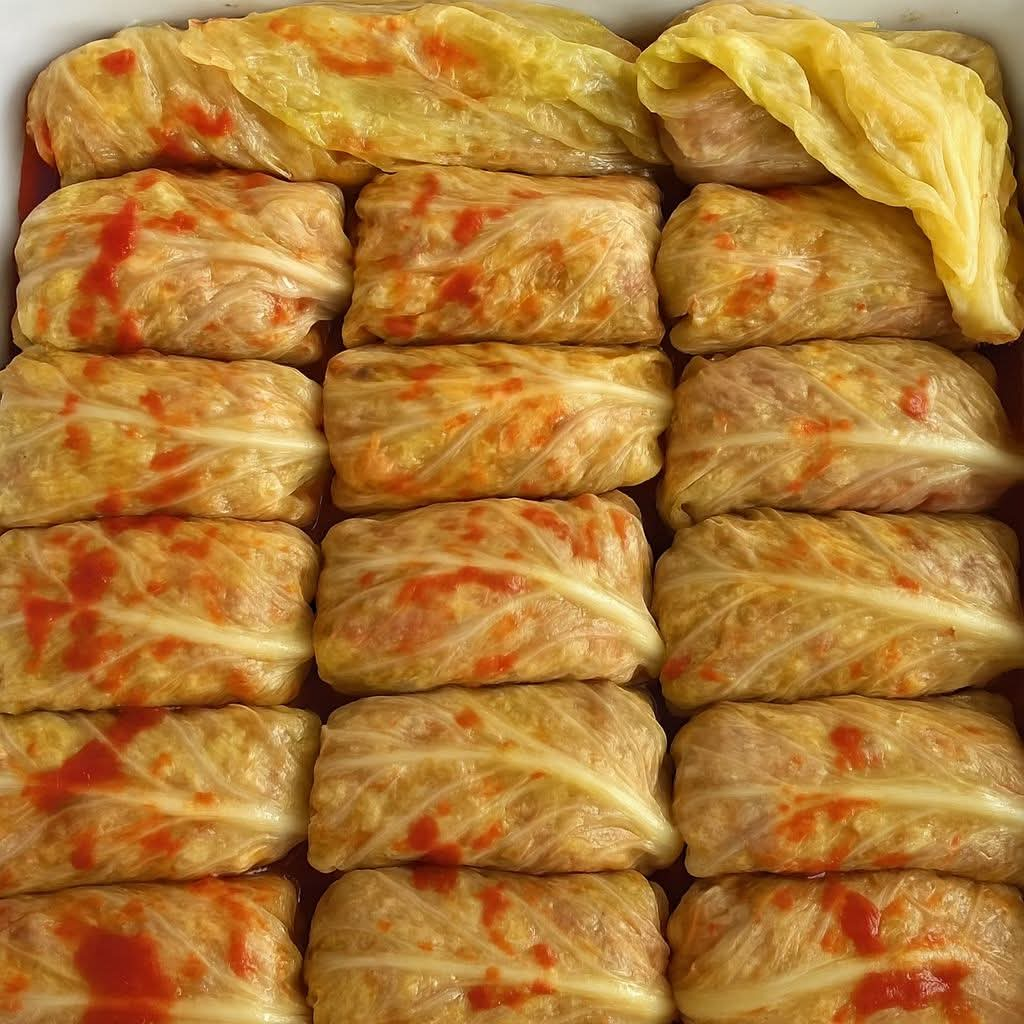Halupki (Stuffed Cabbage Rolls): A Beloved Pennsylvania Tradition of Comfort and Heritage
Halupki, also known as golabki, golumpki, or “pigs in a blanket,” are tender cabbage leaves stuffed with a savory mixture of meat and rice, then slow-cooked in a rich tomato sauce. This humble dish, brought to Pennsylvania by Polish, Slovak, and Ukrainian immigrants, became a cornerstone of family meals across coal towns and steel cities. Affordable, hearty, and deeply comforting, halupki represents generations of hardworking families sharing love through food.
Ingredients
Serves: 6–8
Prep Time: 45 minutes
Cook Time: 1 hour 30 minutes
For the Cabbage Rolls:
- 1 large head of green cabbage
- 1 pound ground beef
- 1 pound ground pork (or use all beef)
- 1 cup cooked white rice
- 1 medium onion, finely chopped
- 2 cloves garlic, minced
- 1 egg, lightly beaten
- Salt and black pepper, to taste
- 1 teaspoon paprika (optional, for warmth)
For the Tomato Sauce:
- 2 tablespoons butter or oil
- 1 small onion, finely chopped
- 2 cloves garlic, minced
- 1 can (28 oz) crushed tomatoes
- 1 cup tomato sauce or tomato juice
- 1 tablespoon brown sugar (optional, to balance acidity)
- 1 tablespoon vinegar or lemon juice
- Salt and pepper to taste
Instructions
1. Prepare the Cabbage:
Bring a large pot of salted water to a boil. Core the cabbage and carefully remove the outer leaves. Blanch the leaves for 2–3 minutes until pliable. Drain and set aside to cool slightly.
2. Make the Filling:
In a large bowl, combine the ground beef, pork, cooked rice, onion, garlic, egg, salt, pepper, and paprika. Mix until well combined but not overly compacted.
3. Assemble the Rolls:
Lay a cabbage leaf flat on a surface, add about 2 tablespoons of filling near the base, fold in the sides, and roll tightly like a small burrito. Repeat with remaining leaves and filling.
4. Prepare the Tomato Sauce:
In a saucepan, heat butter or oil over medium heat. Add onions and garlic and sauté until soft and fragrant. Stir in crushed tomatoes, tomato sauce, brown sugar, and vinegar. Simmer for 10 minutes to develop flavor. Adjust seasoning as needed.
5. Cook the Halupki:
Preheat your oven to 350°F (175°C). Spread a thin layer of tomato sauce on the bottom of a large baking dish or Dutch oven. Arrange the cabbage rolls seam-side down in tight rows. Pour the remaining sauce evenly over the top. Cover with foil and bake for 1½ hours, until the rolls are tender and the sauce is rich.
6. Serve:
Let rest for 10 minutes before serving. Spoon sauce over each roll and enjoy with mashed potatoes, rye bread, or a dollop of sour cream.
Tips for Perfect Halupki
- Choose a large, firm cabbage — it’s easier to roll.
- Don’t overstuff the leaves; the rice expands as it cooks.
- For extra flavor, layer some sauerkraut between rolls before baking.
- These taste even better the next day as the flavors deepen.
Variations
- Old-School Style: Bake the rolls dry and add tomato sauce only when serving.
- With Barley: Substitute rice with barley for a heartier, old-country version.
- Sweet-and-Sour Halupki: Add raisins and a touch more brown sugar for a tangy twist.
- Vegetarian Option: Use lentils, mushrooms, and rice instead of meat.
FAQ
Q: Can I make halupki ahead of time?
Yes, you can assemble them a day in advance and refrigerate. Bake just before serving.
Q: Can halupki be frozen?
Absolutely. Freeze cooked rolls in sauce for up to 3 months. Reheat in the oven or on the stovetop.
Q: My cabbage leaves are tearing — what should I do?
Use two smaller leaves overlapped to wrap one roll. They’ll hold together perfectly once baked.
Q: Can I use only beef?
Yes, but mixing beef and pork gives a richer flavor and juicier texture.
Conclusion
Halupki is more than just a meal — it’s a piece of immigrant history wrapped in cabbage leaves. Each roll carries generations of tradition, comfort, and pride, reminding us of Sunday dinners, family gatherings, and community halls filled with the scent of simmering tomato sauce. Whether you call them halupki, golabki, or pigs in a blanket, one thing’s certain: this timeless dish will always have a place at the table.
